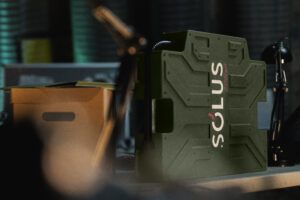The US Military has declared a mission to mitigate and adapt to local weather change by turning into a extra environment friendly drive. To do that it introduced the Military Local weather Technique (ACS) in 2022, which states carbon-cutting initiatives to realize 50% discount in Military web GHG air pollution by 2030 (in comparison with 2005 ranges) and attain net-zero Military GHG emissions by 2050. This consists of the targets of fielding an all-electric light-duty non-tactical automobile (NTV) fleet (classed as passenger automobiles, minivans, passenger vans, and pickup vans and sport-utility autos below 8,500lbs (3,855kg)) by 2027, after which the extra formidable goal of rolling out an all-electric NTV fleet by 2035.
Regardless of greatest intentions, progress on fleet electrification has stalled as a result of dilemma of how the navy can resolve the problem of charging hybrid and battery electrical autos. Working in distant, off-grid, difficult-to-access places the place there isn’t a electrical grid, not to mention cost factors, means supporting the shift to fleet electrification isn’t viable with out the related charging infrastructure.
With the rising demand for vitality on the battlefield comes the better must mobilize it. To assist gas a future electrified navy, UK firm Solus Energy has devised a pioneering transportable energy answer referred to as Kratos, greatest described as ‘Jerry Cans of electrical energy’. The modular Lithium-ion battery packs are superior DC-to-DC items that supply off-grid tactical vitality storage and EV charging with out the necessity for fastened infrastructure.
Established in 2020, Solus Energy founder and CEO, Stas Leonidou, reveals the origin for its Kratos expertise comes from a really completely different, but simply as essential sector.
“It was initially meant for the automotive market,” he says. “Residing in London, I made a decision to purchase an electrical automotive however there have been no cost factors on my highway; those I might discover within the metropolis had been both occupied, damaged, or had simply 7kWh of energy, which might have taken me all day to cost.
“To get rid of the ache factors of EV possession, our idea was a service that would deploy a battery beneath a automobile or stacked up subsequent to it. Utilizing a subscription-based service, we’d be capable to deploy on-demand charging to clients wherever they had been parked.”

Navy manoeuvres
Whereas creating its client EV charging service, Leonidou explains how an encounter with protection and safety firm, QinetiQ, shortly acknowledged how the battery innovation might even have big potential for navy utility, serving a supporting position for automobile electrification.
“The truth of utilizing heavy autos is that diesel must be moved in all places and diesel run mills need to be transported to energy gear,” he says. “That requires some huge cash, bodily area to retailer, and isn’t clear or significantly protected. When you can harvest vitality the place that is no grid, then deploy it on the battlefield it provides protection operational benefit.”
Solus Energy and QinetiQ spent over two years creating the expertise. Constructed for excessive environments, the Lithium-ion cylindrical cell packs are ruggedized to IP67 and bolstered with metal ribs to face up to the burden of 1,543lbs (700kg). Crucially, at 50lbs (23kg) they’re gentle sufficient and sufficiently small (55 x 45 x 11cm) to be manually carried for fast deployment. As a result of nature of its utility, the ability capability of every Kratos pack is presently labeled, via its modular functionality, customers can scale the quantity of vitality to their necessities.
The packs join in sequence utilizing a Excessive-Voltage three-pin flying lead cable delivering an ultrafast cost to the automobile via a DC EV charging cable. The items also can act as environment friendly vitality storage items able to powering gear, drones, and base operations as an alternative of diesel mills.
The choice to create smaller, modular energy items was made early within the growth course of.
“We used sandbags to copy the batteries and bodily modeled how the system would work,” says Leonidou. “There was a giant debate over utilizing one massive battery or going modular. The rationale why we select the modular setup was as a result of many components such because the camber of the highway or the best way individuals park.
“We took clearance measurements of each EV in the marketplace to make sure the battery packs would match below them. After exploring completely different strategies to deploy Kratos, together with utilizing robotic expertise, we quickly realized they need to be dealt with manually for pace, so the packs needed to be gentle and maneuverable.”
Solus Energy is constant to develop the expertise alongside QinetiQ with the goal to convey it to market as quickly as attainable. Leonidou describes how current funding has meant they can expedite the event course of.
“The newest funding isn’t solely testomony to the assumption within the affect of our revolutionary expertise, however it can allow us to speed up its commercialisation. We are going to look to conduct, consider and conclude testing at QinetiQ’s Car Methods Facility in Farnborough. Following that, we’ll unveil a completely functioning demonstrator,” he says. “Our goal is to have Kratos in the marketplace by 2024 in the UK and additional territories afterwards.”

Inexperienced drive
The battlefield is turning into more and more vitality hungry as each the UK and US Military have introduced methods to maneuver to extra sustainable, electrified automobile fleets.
As per the UK Military’s method to battlefield electrification, in 1945 one liter (0.2 gallons) of gas was wanted per soldier per day; as we speak it’s 20 (4 gallons), growing resupply convoys and exposing troops to better threat. One liter of gas offered to a Ahead Working Base requires one other seven to get it there.
In the meantime, the US Military has made efforts to take away over 18,000 fossil gas NTVs from its fleet whereas growing its stock of hybrid autos by virtually 3,000.
These adjustments have already decreased NTV fleet prices by over US$50 million, minimize Military fossil gas consumption by greater than 13 million gallons (49 million liters) per 12 months, and diminished the service’s GHG emissions per mile by over 12%.


